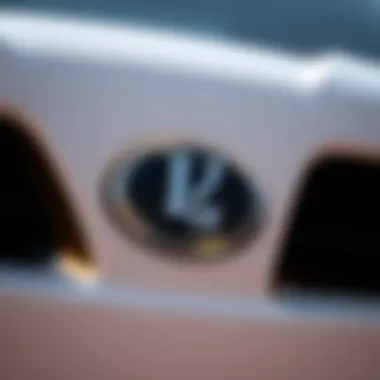Top Luxury Cars: A Comprehensive Analysis of Excellence


Intro
The allure of luxury cars is undeniable; they are not just modes of transport but symbols of status, style, and superior engineering. As enthusiasts and buyers pore over the features and innovations of these elite vehicles, an understanding of vehicle purchasing behavior becomes crucial. It sheds light on what drives individuals to select one luxury model over another. Factors such as performance, design, and brand prestige all play a role. However, so do more nuanced considerations like demographics of buyers and market trends.
The purchasing landscape is constantly shifting, shaped by advancements in technology and changing consumer preferences. Curiously, luxury brands have also adapted to these changes, positioning themselves differently in the competitive market.
In this exploration, we will take a look at the behavior of those indulging in luxury car purchases, market insights, and a comprehensive breakdown of features that truly define these high-end cars.
Vehicle Purchasing Behavior
Understanding what influences someone to purchase a luxury vehicle can reveal a lot about automotive market trends. Many potential buyers dive deep into research, weighing pros and cons before making such a significant investment. Several factors come into play:
Factors Influencing Vehicle Purchases
- Performance Metrics: Speed, acceleration, and handling are non-negotiable for high-end buyers. Brands like Ferrari or Porsche are renowned for their engineering prowess in this area.
- Aesthetic Appeal: The design of a car often speaks volumes about its brand identity, and appealing aesthetics can sway decisions. For example, the curves of a Bugatti Veyron captivate audiences worldwide.
- Technology Integration: Modern luxury cars come packed with tech features. From Apple CarPlay to advanced driver-assist systems, tech-savvy buyers are on the lookout for vehicles that incorporate these innovations seamlessly.
- Brand Reputation: Luxury car buyers often have specific brands in mind, associated with heritage and prestige. Think Mercedes-Benz or Aston Martin—titles that carry weight.
- Sustainability Factors: More buyers are factoring in eco-friendliness into their decisions. Electric models like the Tesla Model S are becoming increasingly popular among buyers who value both luxury and environmental stewardship.
Demographics of Buyers
The demographic landscape among luxury car buyers varies widely. Some standout observations include:
- Age Groups: While younger buyers may tilt towards brands exhibiting innovation rates, older customers might prefer tried-and-true luxury names.
- Income Levels: Naturally, high-income brackets dominate this segment, but emerging affluent individuals are also increasingly interested.
- Global Regions: Regions like North America, Europe, and parts of Asia see a diverse range of luxury vehicle appeals, each influenced by local preferences and cultural contexts.
“Buying a luxury vehicle is not merely about transportation. It’s an experience woven from desires, aspirations, and often, a strongly-positioned social status.”
Prologue to Luxury Automotive Excellence
In the realm of automobiles, the term "luxury" is often tossed around, yet it bears a weight far beyond mere comfort or high price tags. It represents a delicate blend of artistry, performance, innovation, and a touch of history. This article looks to dissect what exactly makes a car fall into the luxury category, focusing on various aspects that contribute to this status and why they matter.
Luxury cars symbolize aspiration. They are not just modes of transport; they are statements of style and lifestyle. For many, owning a luxury vehicle marks a significant achievement, a recognition of one’s hard work and success. These machines are not mere objects; they encapsulate dreams and desires. Thus, understanding the nuances of luxury in the automotive context is essential for both enthusiasts and potential buyers.
Defining Luxury in the Automotive Context
When we talk about luxury, we must delve deeper than just the surface. Luxury in the automotive world can be defined through several lenses. For starters, it is about superior craftsmanship. Luxury cars often feature materials that not only look good but feel good to the touch—everything from soft leather to hand-stitched seams. The meticulous attention to detail sets these vehicles apart from their more mainstream counterparts.
Moreover, performance is equally critical in defining luxury. It’s not just about getting from point A to point B; it’s about the sensations you experience along the way. Think about the purring of an engine that responds to every subtle touch of the accelerator, the ergonomically designed seats that mold to your body, and a driving experience that feels intuitively connected, almost as if the car anticipates your wishes.
Innovative technology also plays a role. Cutting-edge infotainment systems, advanced safety features, and eco-friendliness through electric powertrains are increasingly what discerning consumers are looking for. In the luxury sector, being ahead of the technological curve adds prestige and value. Besides, the blending of technology and traditional craftsmanship is what gives these cars their timeless allure.
The Evolution of Luxury Cars
Looking back, one can see that the concept of luxury cars has undergone significant transformation over the years. In the early 20th century, luxury was often synonymous with size and opulence. Grand, gargantuan vehicles like the Duesenberg Model J or the Cadillac V16 stood tall, providing comfort to the elite who could afford them.
However, as the century progressed, the landscape of luxury cars began to shift. The focus moved from sheer size to performance and efficiency without losing the essence of indulgence. Manufacturers began emphasizing driving pleasure, fuel efficiency, and sleek designs—essentially redefining what luxury meant. The late 20th century saw brands like Mercedes-Benz and BMW carve niches that combined engineering excellence with luxury.
In recent years, environmental concerns have prompted luxury brands to incorporate sustainability into their missions. Electric models like the Tesla Model S are not merely about performance; they represent a shift in values towards eco-friendliness, challenging traditional perceptions of luxury. The lines between luxury and responsibility are blurring, leading to new opportunities and challenges for manufacturers.
Luxury cars today are not just valued for their heritage but also for their ability to adapt and innovate. The evolution tells a story of changing consumer expectations and technological advancements, shaping a new paradigm in the extravagant realms of automotive excellence.
The battleground for luxury is no longer just in the craftsmanship or prestige, but also in how well a brand can adapt to modern values and technology.


Criteria for Selection
In the realm of luxury vehicles, criteria for selection serves as the backbone of any discussion. It is not merely a checklist; it is an exploration into what makes a car truly luxurious. For enthusiasts, buyers, and industry analysts alike, understanding these criteria is essential, as it clarifies what separates a run-of-the-mill automobile from an exquisite piece of machinery.
Performance Metrics
Performance metrics are a critical aspect, often setting the standard for other factors in luxury vehicles. They reflect not just raw power but also sophistication in engineering.
Acceleration and Speed
Acceleration and speed are fundamental attributes that define the thrill of driving a luxury car. For instance, many high-end models like the Porsche 911 Turbo S flaunt staggering acceleration figures, often achieving 0 to 60 mph in under 3 seconds. This characteristic attracts buyers who desire more than simply transportation; they seek an exhilarating experience behind the wheel. However, it's important to note that insane speed comes with its own set of challenges. While rapid acceleration can be a thrilling ride, it may often lead to a traversal of speed limits, raising legal or safety concerns.
Handling and Comfort
When it comes to handling and comfort, luxury cars must strike a balance. Vehicles such as the Mercedes-Benz S-Class offer an unparalleled smoothness while navigating tight corners, making lengthy drives far more enjoyable. This feature not only caters to the driver's needs but also ensures passenger comfort, highlighting a car's role as a haven on wheels. On the downside, focusing too heavily on sporty handling may compromise comfort in daily driving situations, making it less appealing for those who prioritize a plush ride over sharp responses.
Design and Aesthetics
The design and aesthetics of a vehicle are more than mere surface appeal; they symbolize a brand’s identity and craftsmanship.
Interior Materials
The choice of interior materials speaks volumes about the car's luxury level. In cars like the Rolls-Royce Phantom, every surface, from the leather to the wood trim, is meticulously selected for its quality and feel. This attention to detail not only enhances the visual appeal but also elevates the sensory experience of the journey. However, sourcing rare materials can inflate costs, limiting accessibility for the average luxury car buyer.
Exterior Design Philosophy
Exterior design philosophy encapsulates the essence of a brand. Take the Aston Martin DB11, for instance; its sleek lines and bold stance scream sophistication while retaining athleticism. A unique aspect here is the balance between aesthetic beauty and aerodynamics; a well-designed exterior must not only appeal to the eye but also enhance performance. Neglecting functionality in favor of beauty can lead to a vehicle that looks stunning but underperforms in speed and handling.
Innovative Technologies
The role of innovative technologies in luxury cars is paramount, as they determine not just comfort and safety but also the vehicle’s ability to adapt to future trends.
Infotainment Systems
Advanced infotainment systems have become an integral part of luxury driving. Models such as the Tesla Model S offer intuitive interfaces that seamlessly integrate navigation, entertainment, and vehicle settings. This level of connectivity not only enhances the driving experience but also aligns with a tech-savvy consumer base that expects smooth, integrated digital environments. On the flip side, a complex system may overwhelm users who prefer straightforward, user-friendly interfaces.
Safety Features
Safety features constitute another cornerstone of luxury. High-end models like the Volvo XC90 are outfitted with state-of-the-art technology designed to minimize risks. The key characteristic here is a comprehensive suite of active safety features; these are lifesavers that go beyond merely meeting basic regulatory requirements. However, prices can escalate when including the latest safety tech, raising concerns about overall affordability for luxury car enthusiasts.
Brand Heritage and Reputation
The legacy and history of a brand can add significant weight to its luxury status. Iconic brands like Ferrari command respect due to decades of racing pedigree and elite craftsmanship. This heritage often enriches the buying experience, as purchasers feel a part of something larger than themselves. Conversely, new entrants in the luxury space may lack this storied past, making it challenging to establish credibility and attract discerning buyers.
The Pinnacle of Luxury: Top Selections
The segment of luxury automobiles is more than just a market; it embodies aspirations and a commitment to unmatched quality and craftsmanship. Within this realm, the top selections represent the apex of automotive engineering, design, and technological advancements. It is crucial to examine these selections, not merely to highlight their prestige but also to understand the values and innovations that they bring to the consumer experience.
Highlighting the Leading Models


Iconic Brands and Their Flagships
When discussing iconic brands and their flagship models, one cannot overlook the historical significance and brand equity they carry. These are not just cars; they are symbols of status and artful engineering. Take, for instance, the Rolls-Royce Phantom, which is synonymous with regal luxury. Its stunning craftsmanship, with meticulous attention to detail in its interior, makes it a standout choice for those who prioritize tradition and elegance. The unique feature of the Rolls-Royce Phantom is its bespoke interior, where buyers can customize every aspect to their liking—think unique wood finishes, luxury leather options, and even tailored stitching. This flexibility not only enhances the car’s individuality but also creates a deeply personal connection for the owner.
On the other hand, you have the Mercedes-Benz S-Class, recognized for balancing performance with cutting-edge technology. Its innovative safety systems and exceptional ride comfort make it a popular choice among executives. The key characteristic here lies in its ability to incorporate advanced technology without compromising the timeless luxury appeal. While the Phantom may outshine in opulence, the S-Class excels in providing a holistic driving experience. Both vehicles serve as prime examples of what luxury automobiles can achieve, each carving out its niche in the market.
Emerging Contenders in Luxury
While established brands dominate discussions about luxury vehicles, emerging contenders are shaking things up. Brands like Lucid Motors are pioneering a fresh approach to luxury. Their Lucid Air, an all-electric sedan, exemplifies a commitment to sustainability without sacrificing luxury. The unique feature that sets the Lucid Air apart is its extreme range capabilities—boasting over 500 miles on a single charge. This positions it not just as a luxury vehicle but also as a practical choice for the environmentally conscious buyer who expects both performance and sustainability.
Similarly, Polestar, a subsidiary of Volvo, is carving its path with the Polestar 2. Recognized for its minimalist design and agile performance, it represents a shift towards an eco-friendly luxury segment. The key characteristic here is the seamless integration of advanced technology within a Scandinavian design ethos. The undeniable advantage of these emerging brands is that they challenge traditional norms, often offering better value for money compared to their more established counterparts. Yet, their fledgling status might result in some compromises regarding heritage and brand prestige, factors that high-end consumers often look for.
Ultimately, the discussion surrounding leading models in luxury automobiles reveals much about consumer desires and prevailing automotive trends. The wedding of tradition and modernity creates a tapestry of choice that speaks to individuals uniquely, ensuring that the pinnacle of luxury is more accessible than ever.
Brand Profiles
Understanding the profiles of luxury automotive brands allows enthusiasts and potential buyers to appreciate the significant narratives behind each manufacturer. This section serves as a deep dive, examining not just the cars themselves but also the philosophies, histories, and innovations that mark each brand's journey. It’s crucial, as these profiles highlight the heritage and engineering prowess behind these vehicles, drawing connections between the past and present. The experience of owning a luxury car transcends just speed or style; it’s about the legacy that each brand represents.
Porsche: A Legacy of Performance
Porsche has crafted a reputation synonymous with high performance and precision engineering. Founded in 1931, the brand evolved from a consulting firm into a titan of the automotive industry, primarily known for its 911 model — a car that stands as a benchmark in the sports car segment. What sets Porsche apart is its unyielding commitment to performance.
Every model, whether it’s the agile Cayman or the robust Cayenne, is designed with racing in mind, featuring advanced aerodynamics and lightweight materials for better handling. Critics often mention that driving a Porsche feels instinctual, as if the car anticipates the driver's desires. This highlights not just engineering, but also the emotional connection forged between man and machine.
Rolls-Royce: The Art of Bespoke Craftsmanship
Rolls-Royce isn't just about luxury automobiles; it's about creating rolling masterpieces. Established in 1904, the brand has built its identity on an unparalleled level of craftsmanship and individuality. Every Rolls-Royce is bespoke — tailored meticulously to meet the unique desires of its owner, from the material choices to the color palette.
The philosophy behind making each vehicle a one-of-a-kind creation results in a luxurious experience level that's hard to replicate. Materials like fine leather, natural woods, and hand-stitched details separate Rolls-Royce from its competitors, creating a tactile pleasure that is simply unique. The Spirit of Ecstasy emblem encapsulates what the brand stands for: grace, dignity, and unrivaled luxury.
Bentley: Quintessential British Luxury
Bentley represents the pinnacle of British luxury. With roots dating back to 1919, this brand has combined superior craftsmanship with a driving experience that is equally plush and powerful. The Continental GT and Mulsanne models showcase this ethos perfectly, exuding elegance and performance in equal measure.
A standout feature is Bentley's ability to combine heritage with modernity, often seen in their Mulliner customization program, which allows clients to tailor their vehicle to an extraordinary degree. Tailored materials, unique exterior designs, and a driving experience that feels both thrilling and supremely comfortable reflects Bentley’s commitment to exuding class and performance.
Mercedes-Benz: Innovation Meets Tradition
Mercedes-Benz is a name etched in automotive history, known for its blend of luxury, performance and technological advancements. Founded in 1926, the brand has consistently pushed boundaries, whether through innovations like ABS brakes or their pioneering work in car safety. The S-Class serves as the flagship model that encompasses the essence of luxury and cutting-edge technology, often being the first to introduce innovations in the automotive space.
But it doesn't stop there. Mercedes commits to environmental sustainability through its EQ range, showcasing electric vehicles that retain the luxury and performance the brand is known for. The balance between tradition and innovation ensures that Mercedes-Benz remains at the forefront of the luxury automotive landscape.
Ferrari: Engineering Passion
Ferrari is more than a brand; it’s a passion-driven obsession with speed, performance, and racing heritage. Founded by Enzo Ferrari in 1939, this Italian luxury brand lives and breathes motorsport. Each Ferrari is a testament to engineering prowess, often going from racetrack to road in cycle times that astonish.
The distinct roar of a Ferrari engine, its iconic red color, and the famed prancing horse logo create not just a vehicle but a lifestyle for many enthusiasts. Every model, including the 488 GTB and LaFerrari, showcases bold designs and technical excellence. The thrill of driving a Ferrari lies in its ability to connect the driver directly to the car’s raw capabilities, making the experience unforgettable.
The world of luxury automotives is rich with stories and craftsmanship.


These profiles provide deep insights into the luxury car market, showcasing the diverse philosophies each brand embodies. They reveal why these cars are regarded not only as vehicles but as experiences that resonate with the affluent buyers who own them.
Emerging Trends in Luxury Cars
The luxury automobile sector is not just about lavish designs and high-octane performance; it's also where innovation meets necessity. The advent of responsible manufacturing and advanced technologies has shifted the focus of many luxury brands. Understanding emerging trends in luxury cars is crucial for enthusiasts and buyers alike, as these trends not only influence market dynamics but also reflect broader societal changes.
Sustainability in Luxury Automobiles
Electric Luxury Vehicles
The push towards electric luxury vehicles (ELVs) marks a significant turning point in automotive history. For many manufacturers, creating an ELV is not just about sustainability but also about establishing a brand's forward-thinking image. One of the key characteristics of ELVs is their zero-emission power – a game-changer in a world grappling with climate change.
Besides being eco-friendly, ELVs often boast impressive torque that results in quick acceleration, making them an attractive choice for buyers who value performance. The instant power delivery characteristic of electric motors ensures that ELVs can zip from zero to sixty in record time, satisfying both the speed enthusiast and the environmentally-conscious buyer.
However, challenges remain. The limited range of some ELVs can produce anxiety for long-distance travelers, and charging infrastructure varies significantly by region. Still, as this technology evolves, electric luxury vehicles are rapidly becoming synonymous with quality and prestige, breaking barriers that were once set by their gasoline counterparts.
"The future of luxury is silent, sustainable, and speedy. Electric vehicles are not just an option; they’re the new standard."
Bio-materials and Eco-Friendly Practices
Alongside electric powertrains, there's a growing trend toward the use of bio-materials and sustainable practices in luxury automotive design. This trend signifies a commitment not only to luxury but to the environment. For example, upholstery made from recycled plastics or natural fibers is gaining traction. This shift represents a significant move away from traditional materials, highlighting a luxury vehicle's commitment to the planet without compromising on quality.
The hallmark of using bio-materials is their sustainability. These materials often have a lower carbon footprint during production, and their feasibility is becoming more acceptable to high-end consumers who wish to reduce their impact without sacrificing aesthetics or comfort. Unique features, such as biodegradable composites, offer buyers an opportunity to indulge their tastes while also being mindful of ecological balance.
Yet, the challenge lies in convincing traditionalists that these materials meet luxury standards. As brands innovate and educate consumers about their eco-friendly choices, bio-materials are poised to play a pivotal role in defining modern luxury.
Automation and Driving Experience
Advanced Driver-Assistance Systems
Automation in luxury cars is not merely a gimmick; it is a testament to the future of driving. Advanced Driver-Assistance Systems (ADAS) have turned into a standard feature in many luxury vehicles, creating a blend of comfort and safety that was unimaginable a few years ago. Technologies like adaptive cruise control and lane-keeping assist aim to enhance the driving experience, aiming for smooth, hassle-free commutes.
The primary characteristic of ADAS is their ability to reduce human error by assisting drivers in maintaining vehicle control. This technology provides peace of mind, especially in urban settings where traffic can be unpredictable. Luxury consumers are recognizing that these systems not only add convenience but also enhance safety for both occupants and pedestrians.
However, the reliance on these systems can also lead to an unsettling sense of complacency among drivers. There's a delicate balance to achieve between embracing technology and ensuring drivers remain engaged and responsible. This trend emphasizes the evolution of luxury towards a more connected and secure driving experience.
Impact of Autonomous Driving
The impact of autonomous driving on the luxury automotive landscape is profound and multifaceted. As manufacturers innovate towards fully autonomous vehicles, the implications extend far beyond safety. Luxury cars are increasingly viewed as mobile lounges, where the experience shifts from driver-centric to passenger-oriented. This innovation hints at a broader cultural change about how we view commuting.
One defining characteristic of autonomous driving is seat reconfiguration. When cars can drive themselves, the interior can transform into spaces conducive to relaxation or productivity, appealing to a demographic that values time efficiency. The move toward autonomy presents itself as a situation when luxury meets lifestyle, aligning with modern consumers' desires for convenience.
Nevertheless, the transition to fully autonomous vehicles is fraught with technical, ethical, and regulatory challenges. Consumer trust, particularly in high-end markets, must be earned. However, as brands lead this charge and strengthen their technological backbone, there arises the potential for reimagining how luxury is interpreted in the modern age.
Finale: The Future of Luxury in Automotives
As we transition into an era marked by rapid technological change and increasing environmental concerns, the future of luxury automobiles is a topic ripe for exploration. The luxury automotive segment, long viewed as a bastion of performance and opulence, faces shifting expectations from consumers. These shifts not only encapsulate changing demographics but also reflect a more profound societal inclination towards sustainability and innovation.
Enduring Appeal of Luxury Cars
Luxury cars have maintained their allure over decades, appealing to enthusiasts not merely for their specifications but for the experience they offer. Elements such as exquisite craftsmanship, aesthetic beauty, and performance prowess contribute to their iconic status. Buyers often view these vehicles as more than modes of transport; they symbolize success, personal taste, and individuality.
Consider the distinct interior of a Rolls-Royce compared with a sports model from Ferrari. The sumptuous materials used in a Rolls-Royce, coupled with the brand's bespoke options, resonate with a sense of legacy and heritage. On the other hand, a Ferrari channels raw adrenaline—each engine purr like a finely tuned instrument ready to race.
Additionally, the luxury segment is not just holding fast but evolving to resonate with a younger generation. This demographic seeks vehicles that reflect their values and lifestyle.
- Unique Selling Propositions: Brands like Tesla have disrupted traditional luxury paradigms, offering electric vehicles that appeal to tech-savvy buyers.
- Hybrid Models: As customers become more ecologically conscious, luxury brands are increasingly introducing hybrid and fully-electric options, ensuring the continuation of their legacy within a sustainable framework.















